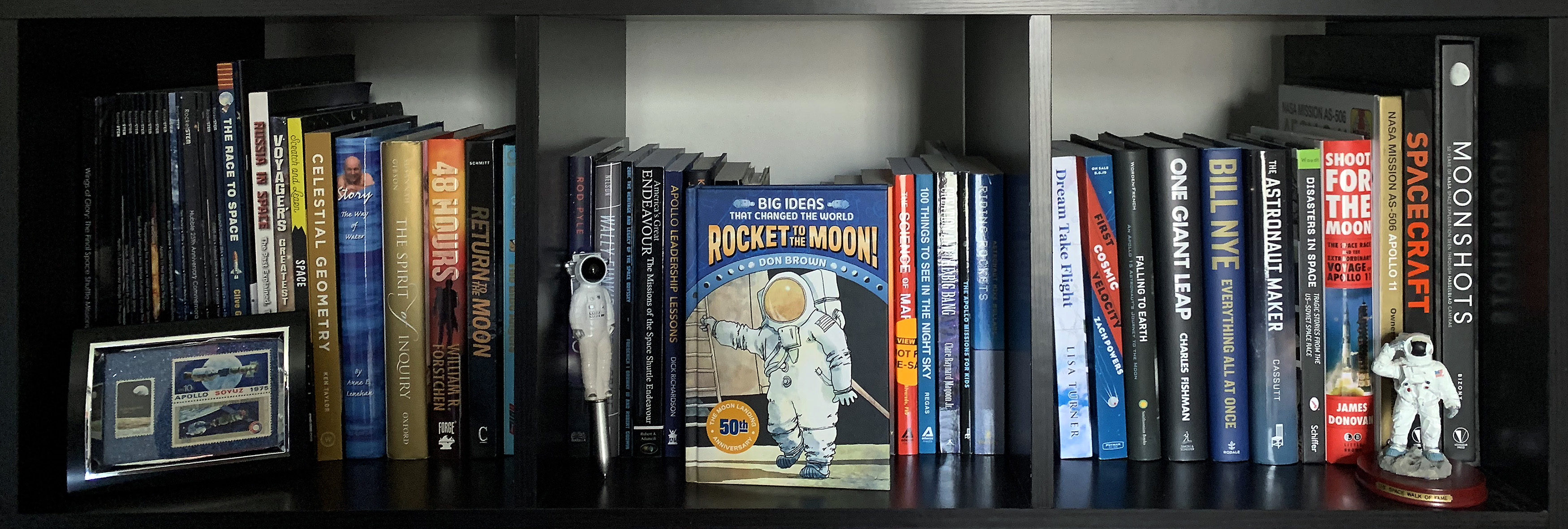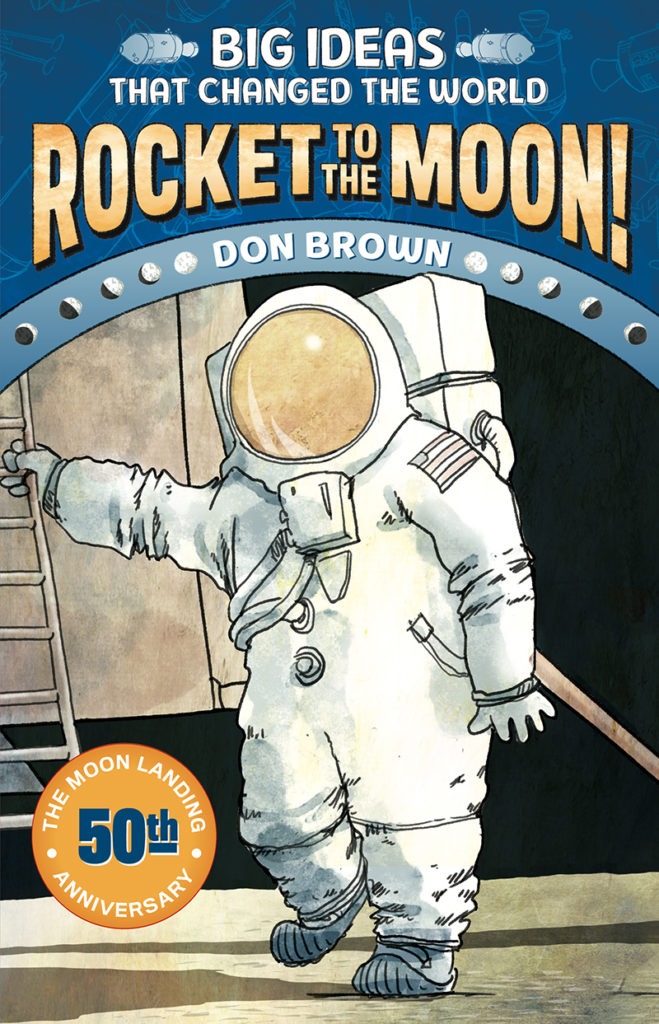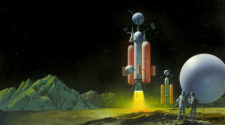 With the 50th anniversary of the Apollo 11 mission to the Moon rapidly approaching, there has been a plethora of books about the Apollo program released during the past year. We’ve been deluged with such books here at RocketSTEM in the past couple of months. That has been a good thing too. The ever-rising stack of books actually sparked the idea of creating Shelf Space, a new section of the RocketSTEM website that is being devoted to highlighting authors and their books about space exploration, astronomy and the sciences. In time we may even start featuring movies, television shows, toys and games.
With the 50th anniversary of the Apollo 11 mission to the Moon rapidly approaching, there has been a plethora of books about the Apollo program released during the past year. We’ve been deluged with such books here at RocketSTEM in the past couple of months. That has been a good thing too. The ever-rising stack of books actually sparked the idea of creating Shelf Space, a new section of the RocketSTEM website that is being devoted to highlighting authors and their books about space exploration, astronomy and the sciences. In time we may even start featuring movies, television shows, toys and games.
Don Brown’s Rocket to the Moon! is the first title in his new “Big Ideas That Changed The World” literary series. So it seemed only appropriate that we feature him and the book as the first new title to be highlighted here on Shelf Space. As Rocket to the Moon! does for the Moon landings, future titles in the series will focus on a Big Idea from initial conception and visualize it all the way to final realization.
Brown is an award-winning author and illustrator of more than two dozen picture-book biographies and narratives of historical events. He has written about difficult modern subjects such as the aftermath of Hurricane Katrina, the Syrian refugee crisis and the 9-11 terrorist attacks in America. He’s profiled famous people such as Neil Armstrong, Thomas Edison, Mark Twain and Albert Einstein as well as tackled events such as the Revolutionary War and the sinking of the Titanic. However, he’s also written about long forgotten subjects such as the 1899 newsboys strike in New York City, Mack Sennett who created the Keystone Cops of cinema, the 1930s Dust Bowl that plagued America, and Mary Kingsley who traveled alone across Africa during the 1890s.
We recently had the opportunity to ask the author a few questions about this latest book and his experiences. As well as learn a couple of details about his next project.
RocketSTEM: Rocket to the Moon! is the first title in your new Big Ideas That Changed The World book series. Why did you decide to undertake this series? And why start with the Moon landings as the first entry?
Don BROWN: “I want the series to remind people that Big Ideas stand on the shoulders of earlier ideas; That they are on a continuum that threads its way through time. The 50th anniversary of the Moon landing offered both the opportunity to celebrate that historic achievement but to also highlight the indispensable innovation and creativity that preceded it.”
RS: Early 20th Century daredevil Rodman Law is a not a person that many people are knowledgeable about. How did you come to learn about him, and why did you choose him as the narrator of Rocket to the Moon!?
BROWN: “I came to learn of Rodman Law through his sister, early aviatrix Ruth Law, who was the subject of my very first book, Ruth Law Thrills A Nation. (I wonder what there was about the Law household that would cultivate two unique and fearless siblings?)
“Rodman was something of the Evel Knievel of his day, parachuting off of skyscrapers and the Statue of Liberty. His plan to rocket himself across New Jersey was equal parts insanity and inspirational…ok, ok it was more insane than inspirational…but then there was much to the space flight program that could strike the casual observer as insane. Anyway, his story resonated with the larger narrative arc of the book and, hey, I wanted to give Rodman his due of fame. (Sad note: He died young of tuberculosis.)”

RS: Rocket to the Moon! is extensively researched and presents the reader with a very basic overview of space exploration. Do you have any specific recommendations as to follow-on reads for those who are piqued to learn more?
BROWN: “I enjoyed the movie Moon Shot and the remembrances of the early astronauts told years after their exploits. Also, take a look at the onboard transcripts of the astronauats’ space flights; the businesslike ordinariness of their conversations while performing extraordinary tasks is fascinating. And the times when their unvarnished honesty shined through, like when they were talking about poo floating in the space capsule, revealed a bit of their simple humanity that I found endearing.”
RS: You previously published a book about the life of Neil Armstrong, as well as books on two early aviators – a balloonist and a female pilot. Were aviation and space exploration things you were fascinated with as a child?
BROWN: “Some of my earliest memories are family visits to a small, local airfield, long since bulldozed and converted to tract housing. But back then, it was the home to small, single-engine planes that rose into the sky with birdlike delicacy. Casual and unregulated, the airfield allowed us to wander among the planes, peer into the cockpits and consider the gizmos – flaps, rudders, motors, and such – that let it fly. Romantic stuff for a six-year old.
“Aviation and spaceflight still fascinate me and I try to keep up with latest technology. Watching reusable rockets land tail-down on the site they launched from strikes me as unbelievable science fiction!”
RS: Have you ever attended the launch of a real rocket or visited any NASA facilities or those of companies such as SpaceX or Boeing?
BROWN: “Sadly, no.”
RS: You not only researched and wrote the book, but you also created all the illustrations within the book. Why do you prefer to take on both tasks with your books?
BROWN: “I was an illustrator before a writer and can’t foresee a book project wherein I would cede the artwork to someone else. And in the case of graphic non-fiction, in which the art and text is uniquely deployed to advance the narrative, being both the illustrator and writer is a tremendous advantage.”
RS: The topics of your books have run the gamut of people and subjects, some of them being quite unknown subjects to people today. Why have you often focused on such obscure personalities and events?
BROWN: “For some reason, people seem to partake only few items from the feast of History. For example, nearly everyone knows about Amelia Earhart yet Harriet Quimby, another doomed pilot, is virtually forgotten. The Harriet Quimbys, the Rodman Laws, and the many others like them whom memory have passed by, are terrific stories that, like all great stories, shed light on the human condition and helps us make sense of our own existence. I like to find and share those forgotten stories.”
RS: How has the process of writing and illustrating your books changed between your first book and your most recent book?
BROWN: “The process has remained the same. First is the idea. Then the research. From the research, I write the manuscript. The art comes last. I like to say, I never think about the art while I’m writing the text, but that’s stretching the truth. If a compelling image comes to me while writing, I’ll slip that element into the story. I wrote Uncommon Traveler about Mary Kingsley, a young British woman who explored Africa in the late Nineteenth Century. I came across a tale in which she brushed aside a hippo with her umbrella. It brought to mind an image I wanted in the book, and so in it went…and happens to be one of my top ten favorite illustrations I’ve made over the last thirty years.”
RS: Many children dream of growing up to become a firefighter, doctor or astronaut? What was your dream profession when you were younger?
BROWN: “I wanted to be an aeronautical engineer. One college semester of physics and calculus proved that I had no aptitude for math or science…sigh.
“Science’s loss, literature’s gain.”
RS: You make yourself available for school presentations. What do you share with the students during these in-school events?
BROWN: “I love meeting kids. My presentations hammer home the truths that history is as cool as any ‘made up’ story and that success is never ever achieved overnight.”
RS: You partnered with Dr. Mike Perfit on the book Older Than Dirt. It starts with The Big Bang and tells the story of Earth from its formation 4.5 billion years ago to present time. The book covers a wide breadth of scientific subjects, from geologic eras and plate tectonics, to the changing of the climate, and humanity’s effect on the planet as a whole. Why did you two pursue this joint project? What is the main message you hope readers take from the book?
BROWN: “Dr. Mike Perfit – Perf to me – is an old, dear friend. In college, his tutoring singlehandedly dragged me over the Calculus 101 finish line. He’s enjoyed a prestigious career in geology, including being the chairman of the University of Florida Geology Department, where he still teaches. His enthusiasm for geology inspired our collaboration on Older Than Dirt. I approached it as biography of the planet; Perf filled in the science. I hope it gives kids a sense of the extraordinary forces working across immense spans of time that have shaped Earth…And to understand the consequences of people’s actions on the future of the planet’s climate.”
RS: Have you decided on the next topic for the Big Ideas series, and if so can you share any information about it with us? Is there a tentative publication date yet?
BROWN: “The next Big Idea’s subject will be the history of computers. Jacquard, Babbage and Lovelace, Turing, Jobs and Wozniak, Gates and Allen…and Muhammad ibn Musa al-Khwarizmi!
“It’s shaping up to be a terrific book!”
Featured book: ‘Rocket to the Moon!’
 In the first book of the “Big Ideas That Changed The Worlds” series, Don Brown takes us back through history to highlight humanity’s journey to reach the stars. Rocket to the Moon! is narrated not by a famous astronaut, but by a relatively unknown daredevil from the early 1900s. The daredevil takes us back to the early bamboo and gunpowder rockets constructed by the Chinese nearly 2000 years ago, then smoothly guides us through the last 500 years of rocket development, first as military weapons, and then as means to reach toward the stars during the last century.
In the first book of the “Big Ideas That Changed The Worlds” series, Don Brown takes us back through history to highlight humanity’s journey to reach the stars. Rocket to the Moon! is narrated not by a famous astronaut, but by a relatively unknown daredevil from the early 1900s. The daredevil takes us back to the early bamboo and gunpowder rockets constructed by the Chinese nearly 2000 years ago, then smoothly guides us through the last 500 years of rocket development, first as military weapons, and then as means to reach toward the stars during the last century.
The book is richly illustrated while the narrative is entertaining and informative. It highlights the early rocket scientists and quickly moves the reader past WWII, Sputnik, Project Mercury and the Gemini Program before settling on the Apollo program for the remainder of the book. Naturally, the focus is primarily on the Apollo 11 mission where Neil Armstrong and Buzz Aldrin took humanity’s first step on the lunar surface. However, each Apollo mission is spotlighted, from the deadly fire of Apollo 1 through Gene Cernan’s last steps on the Moon as part of the Apollo 17 mission.
As we celebrate the 50th anniversary of the first Moon landing, Rocket to the Moon! is an excellent starting point for younger readers to learn about the Space Race between the Americans and the Soviets of the 1960s. It covers the basics while providing a peppering of extra details without weighting down the material too much for children.
Included at the end of the book is an extensive section of endnotes, a multi-media bibliography, author’s note and index.
Ad astra per litterarum!
Praise from others
“Keeping the tone light and offering nods as he goes to historical figures…he focuses on technological advances that made space travel possible and on the awesome, sustained effort that brought President John F. Kennedy’s “Big Idea” to fruition…A frank, often funny appreciation of our space program’s high-water mark.
— Kirkus Reviews
“A broad yet eye-opening tribute to the astronauts’ achievements…The Big Ideas That Changed the World series is off to a promising start with this illuminating, cogent volume.”
— Booklist
“Engaging…[Brown] peppers the oft-told tale with details that don’t always make it to the textbooks.”
— The Bulletin of the Center for Children’s Books
“Brown’s visual storytelling offers humor, vibrancy, and a wealth of historical insight.”
— Publishers Weekly
Review book details
Age Range: 8-12 years
Grade Level: 3 – 7
Hardcover: 136 pages
Publisher: Amulet Books/Abrams (March 5, 2019)
Language: English
ISBN-10: 1419734040
ISBN-13: 978-1419734045
Goodreads’ Rating Details: 3.86



